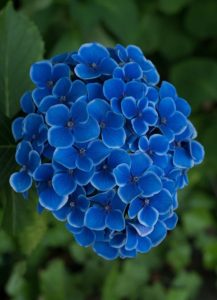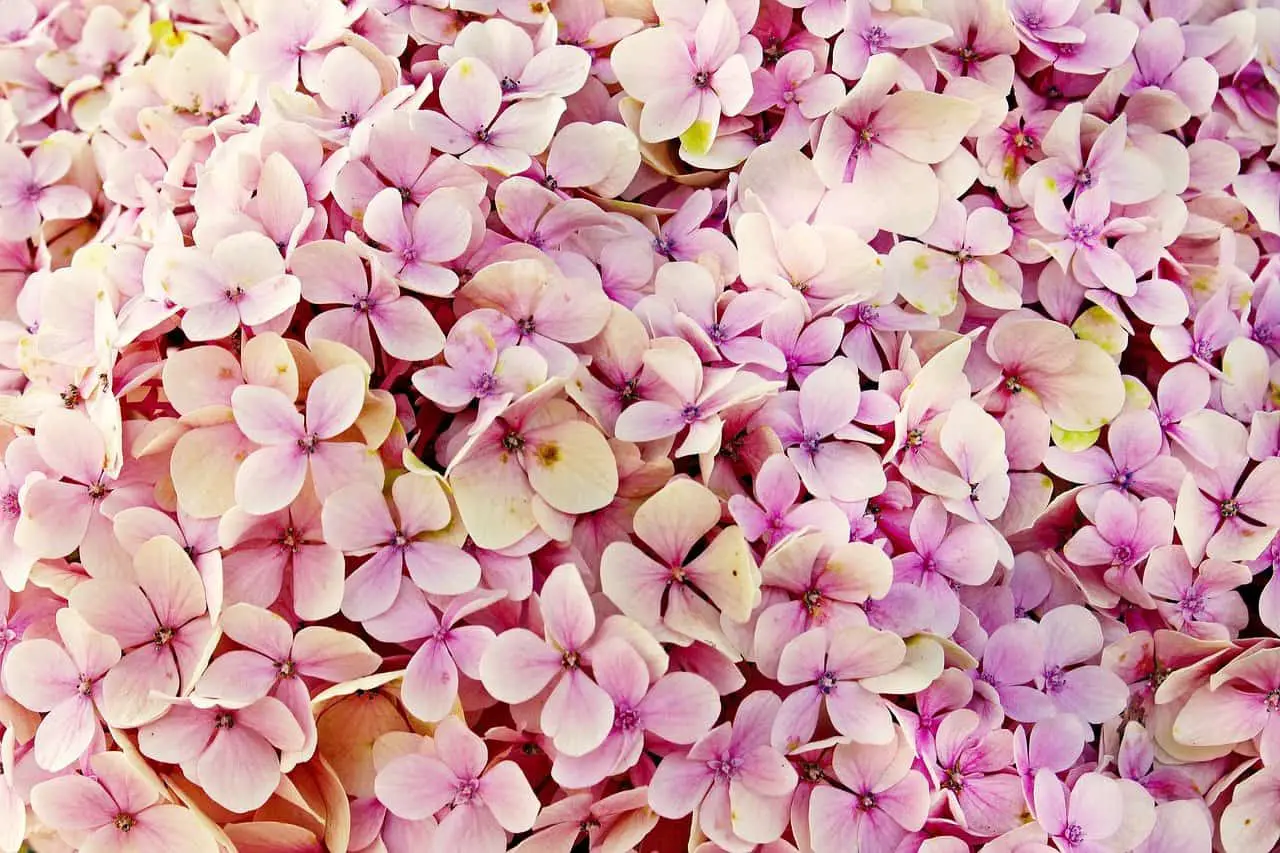Some links in the post are affiliate links and I get a commission from purchases made through some links found in the post.
Are you looking for a guide to grow, care for, and make natural fertilizer for your hydrangeas? Then you have come to the right place.
Hydrangeas are large globes of flowers that look absolutely stunning in your home garden or anywhere else!
Their appearance makes it seem like they are high maintenance, but if you provide them with the proper care they need, you will grow some beautiful hydrangeas in no time!
Hydrangeas bloom in summer and spring and are considered shrubs. There are four types of hydrangeas:
Big Leaf Hydrangea: This type of hydrangea changes color depending on the soil pH. The large flowers usually grow in the shades of pink, lavender, and blue.
Panicle Hydrangea: This is a tree type of hydrangeas and is difficult to grow!
Oakleaf Hydrangea: You should plant this type of hydrangea in the shade. It starts flowering from mid to late spring.
Climbing Hydrangea: This type of hydrangea is also grown in shade and blooms from late spring to mid-summer.
What Do Hydrangeas Need?
 It would be best if you were careful when it comes to hydrangeas care. We have listed some simple steps to follow if you want greener leaves.
It would be best if you were careful when it comes to hydrangeas care. We have listed some simple steps to follow if you want greener leaves.
Although simple and easy steps, make sure to follow them to have a healthier and fresher hydrangea.
- For greener leaves, you need to give your hydrangea a boost of nitrogen. You can make nitrogen tea or use aquarium water.
- After you plant your hydrangea, make sure to water them at a rate of 1inch per week. If the soil is too dry, your leaves might wilt, and flower growth might also get affected.
- You won’t need fertilizer if your soil is fertilized; however, make sure to give your hydrangea some light fertilizer application during the bloom season.
- Try to cover your plants at least 18 inches in winter. As this plant blooms in summer and spring, covering it with maple leaves might suffocate the plant, so try to use snow fencing instead.
If you’re enjoying this article, check out our article on why are my hydrangea leaves curling.
How to Make Natural Fertilizer for Hydrangeas
If you are looking for ways to fertilize your hydrangeas naturally, then keep reading as we have made a step-by-step guide to understand better how to make a natural fertilizer.
1) Flower Growth
Hydrangeas need magnesium, iron, and calcium to grow. Add a teaspoon of vinegar in a quarter of water to encourage the growth of flowers.
You can also use animal compost under the soil as a fertilizer for better flower growth.
2) Better Color
A more acidic soil is a good option for a blossomed color of your hydrangeas.
If you are looking for pink-toned blossoms, you can add some wood ashes to the soil to enhance your hydrangeas’ color.
3) Greener Leaves
You can create nitrogen tea for greener leaves. Making this type of tea is by soaking some grass clippings in a bucket full of water.
Leave it for three days, then strain it and pour the liquid on the roots of your hydrangea bush. This tea will certainly make your hydrangeas leaves greener.
4) Overall Health
As a general rule, compost and manure are good plant nutrition.
You can add some compost tea by filling water in a bucket and let it sit for some days stir it every day.
After this, strain this water and pour it directly under your hydrangea.
Some other natural fertilizers you can make at home are listed below! Keep reading to find out more about how to keep your hydrangeas happy and healthy if they have started to look sad!
Baking Soda
Water your hydrangea with this baking soda water to make them healthy!
- Mix a teaspoon of baking soda in a quart of water.
- Use that water for watering the plants.
Since hydrangeas thrive in alkaline, this trick will make your flowers beautiful and help them grow!
Banana Peels
There are a couple of ways to use banana peels in your garden. Banana peels are a good source of potassium that promotes flowers’ growth and are good for growing hydrangeas.
Here’s how to use a banana peel for hydrangeas:
- Dry the banana peel for two to three days.
- Dry them till they turn crisp.
- Now grind the banana peels and make sure the pieces are smaller than half an inch.
- Sprinkle these shredded banana peels evenly around your hydrangea.
This will act as a slow fertilizer for the plant, slowly releasing the nutrients into the soil.
Another way to use banana peels is to make compost from them. Here’s how to make it:
- Cut banana peels with scissors.
- The size should not exceed half an inch.
- Add some green foliage from trees or shrubs for your garden and add it to the compost.
This will also help your hydrangea to grow better and stay healthy for a long time!
If you have been growing your own bananas for your hydrangeas then our article on why are my banana plant leaves turning yellow may interest you.
Coffee Grounds
 We all have leftover coffee grounds in our kitchen after we are done brewing our coffee! It is best to use this as compost or directly use them on your plants.
We all have leftover coffee grounds in our kitchen after we are done brewing our coffee! It is best to use this as compost or directly use them on your plants.
Coffee lovers and plant lovers will love this hack! It would be best if you sprinkled some leftover coffee grounds on your hydrangeas.
The carbon factors in coffee grounds make it extremely beneficial for the growth of your plants.
You can also use a liquid feeder from coffee grounds. Here’s how to do that:
- Take a handful of coffee and put it in a bucket of water.
- Leave it for a day or two.
- This will create a liquid that is perfect for feeding your plants!
Coffee grounds also help in keeping those bugs away from your precious plants. Sprinkle them around your plants to avoid pests getting close to your plants.
How Often Should you Fertilize your Hydrangea?
It is essential to know how often you need to fertilize hydrangeas. Fertilizer burns can occur if hydrangeas are fertilized too much.
They should be fertilized with fast release fertilizer between March and July. The first sign to see for too much fertilizing is scorched leaves. To prevent your hydrangea from getting leaf scorched, check out our article here.
Make sure you pour the fertilizer the hydrangea around branches and not just the base.
Watering well is also essential when it comes to hydrangeas. But overwatering them can lead to some negative effects on the plants. We have an article on how much water do hydrangeas need.
Harmful Fertilizers for Hydrangeas
Fertilizing hydrangeas is essential for them, but certain fertilizers might harm your plant.
Make sure to use a fast releasing fertilizer a few times a year. Usually between spring and early fall. It is also not necessary to always keep your hydrangeas fertilized.
They can bloom just fine if you fertilize them a little less than you would. Yellow leaves in the center mean that now your plant requires a fast pace fertilizer.
For blue and purple blooms, make sure to use a fertilizer that is low in sulfate. Try to avoid using Epsom salt on your hydrangeas.
Although some say it is good for your plants, many people recommend not using it on your hydrangeas that might cause them to wilt.
It might not help in healthily growing your hydrangeas, so it is better to avoid using it!
General Tips for Hydrangeas
1) Plant your hydrangea at an appropriate width and length. Dig a slightly deeper hole than the ball’s root, preferably 2 to three times wider than the root ball. Give them lots of space to spread out to!
2) Plant your hydrangeas where they will get morning and afternoon sun directly. Hydrangeas love the morning sun!
3) It would be best if you gave your hydrangeas some yummy soil to grow in! Hydrangeas thrive in good soil, so make sure to mix some organic matter in your soil before planting the hydrangea.
4) Try not to crowd your hydrangeas. Hydrangeas love their space and might not thrive if given less space. Make sure to plant them at least 3 feet apart so that they do not harm each other.
5) Pruning is also a good way to let your hydrangea thrive. Cut back the old and damaged stems and leave the blooms for fall clean up!
6) Try to use natural repellents to keep the slugs and bugs away. Try keeping a slug trap around your plant, or you can also place eggshells around your plant to keep it away from slugs and bugs!
When Should you Plant your Hydrangeas?
Although there’s no simple answer to this question, it is best to plant your hydrangeas from April to September.
Planting them in 80 degrees will be too hot for hydrangeas, and less than 40 degrees will be too cold for them.
So it is better to plant your hydrangeas when it is neither too hot nor too cold!
Final Thoughts: How to Make a Natural Fertilizer for Hydrangeas
 This was all about everyone’s favorite plant, hydrangeas! Hydrangeas sure add to the beauty of your garden!
This was all about everyone’s favorite plant, hydrangeas! Hydrangeas sure add to the beauty of your garden!
Even if you’re not a pro at gardening or are just a beginner, you can start with hydrangeas since this plant is easy to take care of and looks absolutely beautiful in your garden, whether indoor or outdoor!
A natural fertilizer will help your hydrangeas to grow but make sure to give them the right boost they need at the right time!
Happy Planting!
Before you go, here are some more related articles I encourage you to read below to help solve more of your gardening issues:
Common Problems with Hydrangeas in Pots
How to Landscape with Hydrangeas


